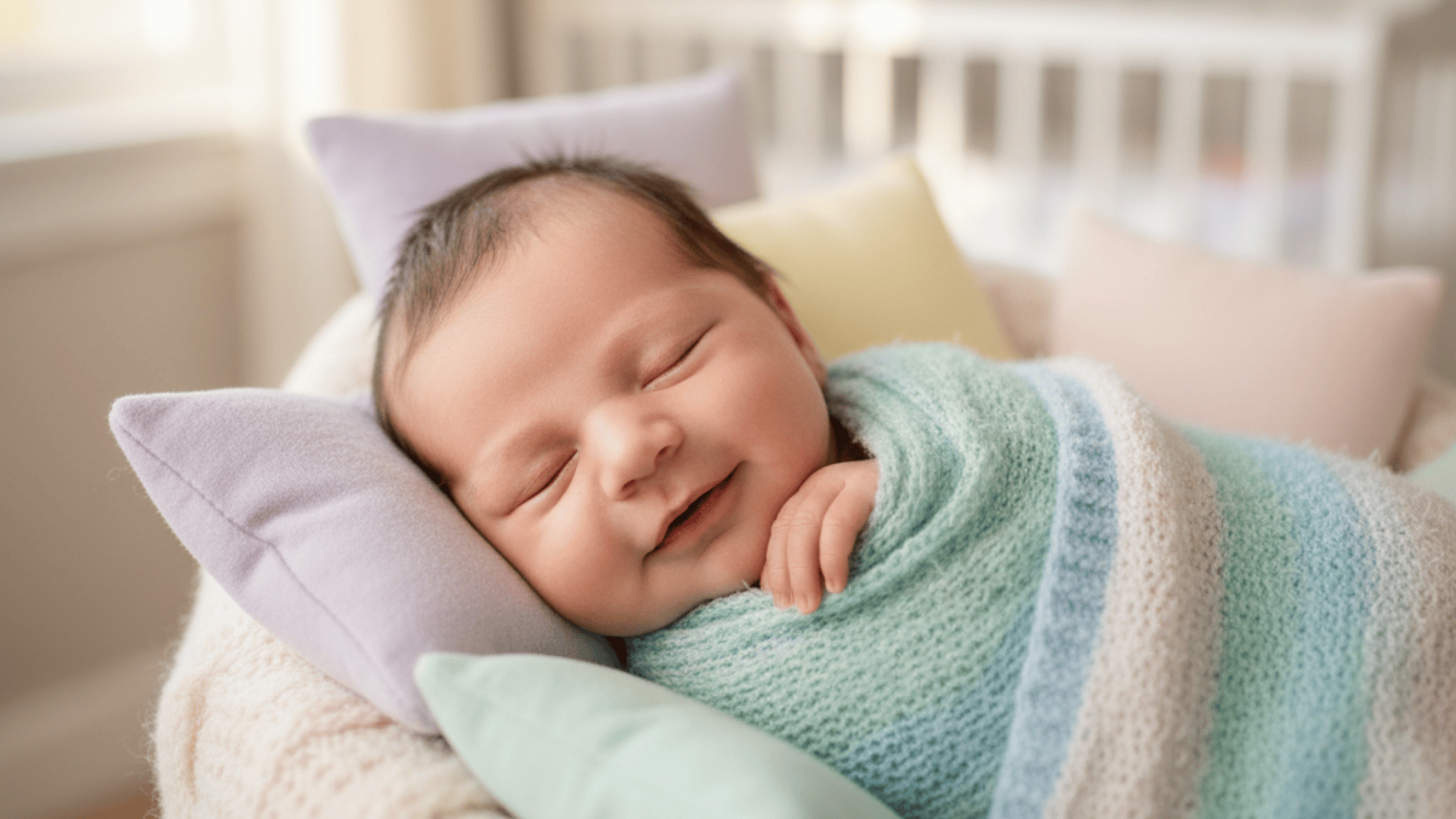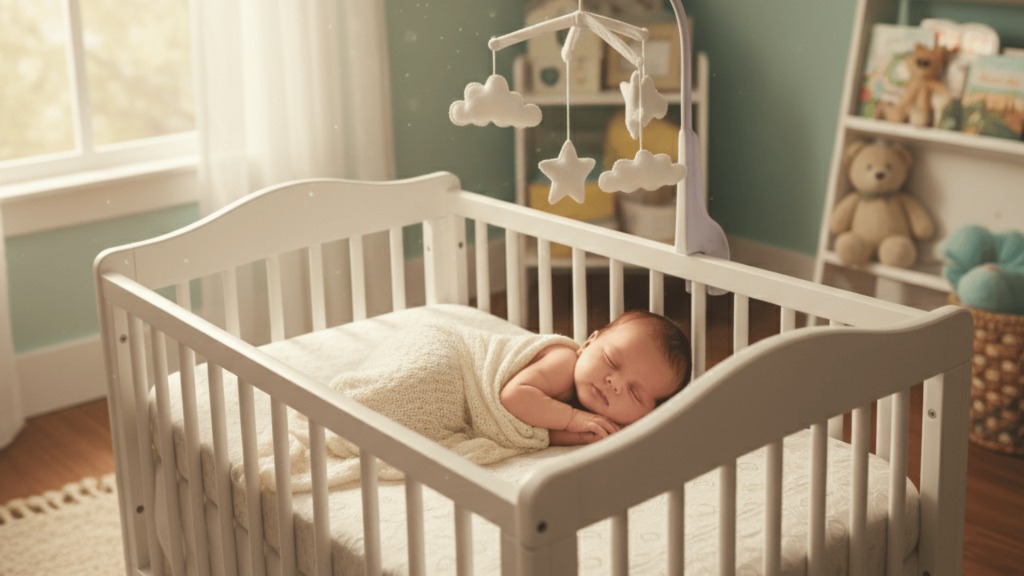Have you ever watched your baby sleep and noticed a little grin appear on their face? I know how quickly it makes you wonder why do babies smile in their sleep. Is it a dream, a reflex, or something more?
In this blog, you and I will walk through the real reasons behind those sleepy smiles. We’ll look at sleep patterns, brain activity, and development, while also touching on what parents often believe about them.
From neurological explanations to emotional and even cultural interpretations, you’ll get the full picture.
By the end, you’ll understand both the science and the sentiment behind this sweet part of babyhood, and feel reassured the next time you see it.
Understanding Baby Sleep Patterns
Babies don’t sleep the same way adults do. Their sleep is broken into cycles, and each cycle has different stages.
- REM sleep (Rapid Eye Movement): This is the active stage where the brain is busy building connections and processing new experiences. Babies may twitch, move their eyes quickly, or break into little smiles as their brains “practice” activity.
- Non-REM sleep: This is the deeper, quieter stage where the body focuses on growth and repair. During this stage, babies breathe more evenly, remain still, and their bodies release growth hormones to support their development.
Newborns and young infants spend much more time in REM sleep than adults. This stage is linked to brain growth and memory development.
The extra REM time is one reason you might notice little facial expressions, like smiles, while your baby is sleeping.
Why Do Newborns Smile in Their Sleep?

Seeing a baby smile in their sleep is one of the sweetest sights for any parent. But those tiny grins aren’t just cute; they have real reasons behind them. Both the brain and the body play a part in making it happen.
Neurological Explanation
Not every smile you see in your baby’s sleep is an emotional response. Many are caused by how the brain and nervous system work during sleep.
- Reflexive smiling: In the early weeks, smiles are automatic reflexes controlled by the brainstem. They happen naturally and aren’t connected to feelings or social interaction.
- REM sleep activity: Babies spend a lot of time in REM sleep, when the brain is very active. This activity can trigger small muscle movements in the face, leading to twitches or smiles.
- Developing nervous system: As the brain grows, it practices sending signals to different parts of the body. Sleep smiles are one way these pathways are tested and strengthened.
Developmental Reasons for Newborn Smiling in Sleep
Smiling during sleep isn’t random. It plays an important role in how babies develop, both physically and socially. These small smiles are part of the way the brain and body learn to work together:
- Practice for real smiles: Sleep smiles help babies move and strengthen the tiny muscles in their face. Over time, this practice allows them to smile intentionally when they’re awake.
- Smiling as a milestone: A smile is one of the first signs of development that parents look for. It shows that a baby’s nervous system and muscle control are improving.
- Reflex smiles: These appear from birth and are automatic, coming from the brainstem. They don’t carry emotion but signal that the body’s reflex systems are active.
- Social smiles: By around 6–8 weeks, babies begin smiling in response to familiar faces and voices. This marks the shift from reflexive action to true social interaction.
- Growth link: Smiling connects to multiple areas of growth, including physical (muscle control), emotional (early expression), and social (interaction with others).
Smiles during sleep are both natural and important. They show how quickly a baby’s brain and body are developing, while also giving parents moments of pure joy to treasure.
The Dream Connection: Are Babies Dreaming?
Many parents wonder if the little smiles their baby makes during sleep mean they are dreaming. Science gives some clues, but cultural beliefs and parental feelings also play a role.
Babies spend nearly half of their sleep in REM, the stage linked to dreaming in adults. During this time, their brains are very active, processing memory and learning. For infants, REM may help sort the many new sights, sounds, and sensations they experience each day.
Still, studies cannot confirm what babies actually see or imagine. If infants do dream, experts believe the content is simple, such as flashes of faces, familiar voices, or basic sensations, rather than the detailed dreams adults recall.
In many cultures, sleep smiles are seen as more than biology. Some believe babies are visited by angels, while others feel they are connected to loved ones who have passed. These interpretations often bring parents comfort and reassurance.
Parents’ Observations and Thoughts
Parents often see more than science when their baby smiles in sleep. These moments feel special and carry personal meaning that goes beyond brain activity or reflexes.
Common interpretations suggest that many parents believe their baby is dreaming of angels, reliving happy moments, or hearing a familiar voice. These ideas give the smiles a comforting and joyful explanation.
The emotional impact of watching a baby smile in sleep can be deeply moving. It reassures parents, builds emotional bonds, and makes them feel connected to their child in new ways.
Science and sentiment go together, while research points to reflexes and REM activity, parents naturally add their own meaning. This blend of science and personal belief helps families appreciate both the facts and the feelings behind those little smiles.
For parents, these smiles are more than biology. They are treasured moments that bring reassurance, joy, and a sense of wonder about their baby’s inner world.
When to Expect Sleep Smiles
Parents often wonder when they’ll see those little smiles and what they mean. The timing depends on the baby’s stage of development, but there are some general patterns:
- Newborn phase: In the first weeks, most smiles are reflexive. These appear during sleep and are caused by brainstem activity, not emotions.
- Around 6–8 weeks: Babies begin to show real social smiles. At this stage, they may smile in response to your face, voice, or touch. Sleep smiles may also appear alongside these intentional ones.
- Variations among babies: Some babies smile earlier, while others take longer. Both can be normal. As long as your baby is feeding, growing, and interacting in other ways, small differences in timing are not a concern.
In short, sleep smiles start as reflexes and gradually turn into meaningful expressions. The timeline may vary, but each smile is a healthy sign of growth and development.
When to Be Concerned

Most sleep smiles are a normal part of development, but parents sometimes worry about what they see. Knowing what’s typical and when to ask for help can bring peace of mind:
| Signs | What It Means | Examples |
|---|---|---|
| Healthy Signs | Normal newborn behaviors that show the nervous system is developing. | – Smiles, twitches, or quick eye movements during REM sleep- Short bursts of facial movement or small grins- Common in newborn months and signal healthy growth |
| Red Flags | Patterns that may point to a problem and should be monitored. | – Constant twitching that lasts for long stretches- Stiff movements that don’t relax- Smiling paired with unusual jerks, uneven breathing, or eyes rolling back |
Consult a Doctor in Case Of
- Smiles paired with repeated tremors or shaking that doesn’t stop
- Stiff or jerky movements that don’t relax
- Long pauses in breathing or uneven breathing during sleep
- Eyes rolling back while smiling
- Constant twitching that lasts for long stretches
- Any sleep behavior that makes you feel uneasy as a parent
Conclusion
So now you know the answer to why do babies smile in their sleep.
We’ve looked at how sleep cycles, reflexes, and a developing nervous system explain those tiny grins, and how parents often add their own meaning, like happy dreams or comforting visits.
I think it’s fascinating that science and sentiment can both be true in their own way. For you, this means each little smile is not just cute but also a sign of healthy growth.
Next time you see one, you’ll know why newborns smile in their sleep. Now its your turn, share this blog with your friends or leave a comment about your own baby’s sleepy smiles!











